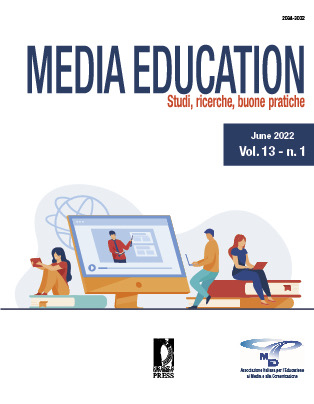Children and Context-aware Inclusive Tuning of Cartoons. Design of multimedia contents in an inclusive perspective
Published 2022-05-02
Keywords
- Artificial Intelligence,
- Behaviour analysis,
- Context-awareness,
- Inclusive Cartoons,
- Media Education
- Information and Communication Technology ...More
Abstract
Thanks to the specific characteristics of multimedia language, cartoons can transmit significant messages to viewers, both emotionally and rationally: this contribution reflects on the potential of cartoons to facilitate and support inclusive processes (also) regarding children with disabilities. In addition to examining functional strategies for promoting a more aware and more active use by all subjects, the article proposes a possible use of Artificial Intelligence to support the dialogue between Media Education and inclusive processes. On one level, the adult (educator, teacher or parent) has the task of observing the child during viewing, interacting with the child and encouraging verbalization about what has been seen: technologies can offer additional data compared to what has been observed, allowing for an even more targeted way of acting with respect to the specific needs of each child. On another level, one can use the same data to create even more interactive content that allows the narration to adapt to the specific wishes, attitudes and needs of each child. Striving in the direction of educating the media, with the media and for the media, the article promotes a conscious and critical use of technologies: useful tools for both education professionals and family members.
References
Antoniazzi, A. (2015). Dai Puffi a Peppa Pig: media e modelli educativi. Carocci editore.
Besio, S., Bulgarelli, D., & Stancheva-Popkostadinova, V. (2017). Play development in children with disabilities. De Gruyter Open Ltd, Warsaw/Berlin Part of Walter de Gruyter GmbH, Berlin/Boston. https://www.degruyter.com/document/doi/10.1515/9783110522143/html
Bianquin, N. (2017). LUDI - Play for Children with Disabilities: l’interdisciplinarietà a supporto di un nuovo modello di intervento per il gioco del bambino con disabilità. Italian Journal of Special Education for Inclusion, 5(1), 15-31. https://ojs.pensamultimedia.it/index.php/sipes/article/view/2315/2076
Bolter, J. D., & Grusin, R. (1999). Remediation: Understanding New Media. Mit Pr.
Booth, T., Ainscow, M., & Kingston, D. (2006). Index for Inclusion: Developing Play, Learning and Participation in Early Years and Childcare. Centre for Studies on Inclusive Education. https://www.eenet.org.uk/resources/docs/Index%20EY%20English.pdf
Cappuccio, G. (2015). Cartoons di qualità per la prima infanzia. I bambini e la media education. Aracne.
Committee on the Rights of the Child (CRC) (2013). General comment No. 17 (2013) on the right of the child to rest, leisure, play, recreational activities, cultural life and the arts (art. 31). https://www.refworld.org/docid/51ef9bcc4.html
Cottini, L., Vivanti, G., Bonci, B., & Centra, R. (A cura di) (2017). Autismo come e cosa fare con bambini e ragazzi a scuola. Giunti Editore.
Eco, U. (1994). Sei passeggiate nei boschi narrativi. Bompiani.
Felce, D., & Perry, J. (1995). Quality of life: Its definition and measurement. Research in Developmental Disabilities, 16(1), 51–74. Elsevier Scienze Ltd.
Felini, D., & Di Bari, C. (A cura di) (2019). Il valore delle differenze. Tra teorie e pratiche educative. Junior.
Fondazione ISMU. (2021). Ventiseiesimo Rapporto sulle migrazioni 2020. FrancoAngeli.
Gardou, C. (2016). Nessuna vita è minuscola. Per una società inclusiva. Mondadori Università.
Lucattini, P., Jayousi, S., Martinelli, A., Mucchi, L., & Lombardi, G. (2019). Social Inclusion for Children with Disabilities: The Role of ICT in Play and Entertainment Activities. In L. Mucchi, M. Hämäläinen, S. Jayousi, & S. Morosi (Eds.), Body Area Networks: Smart IoT and Big Data for Intelligent Health Management. Lecture Notes of the Institute for Computer Sciences, Social Informatics and Telecommunications Engineering, vol 297 (pp. 281-300). Springer.
Manzoor, M., & Vimarlund, V. (2018). Digital technologies for social inclusion of individuals with disabilities. Health and technology, 8(5), 377-390. https://www.ncbi.nlm.nih.gov/pmc/articles/PMC6208746/pdf/12553_2018_Article_239.pdf
Masterman, L. (1985). Teaching the media. Routledge.
Njoki, M., & Wabwoba, F. (2015). The Role of ICT in Social Inclusion: A Review of Literature. International Journal of Science and Research, 4(12), 380-387. https://www.ijsr.net/get_abstract.php?paper_id=NOV151897
Ott, M., & Pozzi, F. (2009). Inclusive education and ICT: reflecting on tools and methods. In Assistive Technology from Adapted Equipment to Inclusive Environments (pp. 635-639). IOS Press. https://citeseerx.ist.psu.edu/viewdoc/download?doi=10.1.1.725.5634&rep=rep1&type=pdf
Perasso, G., Camurati, G., Morrin, E., Dill, C., Dolidze, K., Clegg, T., Simonelli, I., Lo, HYC., Magione-Standish, A., Pansier, B., Gulyurtlu, SC., Garone, A., & Rippen, H. (2021). Five Reasons Why Pediatric Settings Should Integrate the Play Specialist and Five Issues in Practice. Frontiers in Psychology, 12(687292). https://www.frontiersin.org/articles/10.3389/fpsyg.2021.687292/full
Postman, N. (1979). Teaching As a Conserving Activity. Delacorte Pr.
Ranieri, M. (2011). Le insidie dell’ovvio. Tecnologie educative e critica della retorica tecnocentrica. Edizioni ETS.
Rideout, V., & Robb, M. B. (2019). The Common Sense Census: Media Use By Tweens and Teens, 2019. Common Sense Media. https://www.commonsensemedia.org/sites/default/files/uploads/research/2019-census-8-to-18-key-findings-updated.pdf
Rivoltella, P. C. (2019). Media Education. Idea, metodo, ricerca. Scholè.
Shalash, W.M., AlTamimi, S., Abdu, E., & Barom, A. (2018). No limit: A Down Syndrome Children Educational Game. In 2018 IEEE Games, Entertainment, Media Conference (GEM) (pp. 352-358). https://zh.booksc.me/book/74227513/50d9ae
Tisseron, S. (2013). 3-6-9-12. Apprivoiser les écreans et grandir. Érès.
United Nations (UN). (2006). Convention on the Rights of Persons with Disabilities. https://www.un.org/development/desa/disabilities/convention-on-the-rights-of-persons-with-disabilities.html
van den Heuvel, R. J. F. (2018). The next generation of play: robots to support play in rehabilitation and special education for children with physical disabilities. Datawyse/Universitaire Pers Maastricht.

